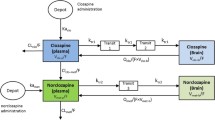Abstract
Purpose. A mechanism-based model is applied to analyse adaptivechanges in the pharmacodynamics of benzodiazepines upon chronictreatment in rats.
Methods. The pharmacodynamics of midazolam was studied in ratswhich received a constant rate infusion of the drug for 14 days, resultingin a steady-state concentration of 102 ± 8 ng·ml−1. Vehicle treated ratswere used as controls. Concentration-EEG effect data were analysed onbasis of the operational model of agonism. The results were comparedto data obtained in vitro in a brain synaptoneurosomal preparation.
Results. The relationship between midazolam concentration and EEGeffect was non-linear. In midazolam pre-treated rats the maximum EEGeffect was reduced by 51 ± 23 μV from the original value of 109 ±15 μV in vehicle treated group. Analysis of this change on basis ofthe operational model of agonism showed that it can be explained bya change in the parameter tissue maximum (Em) rather than efficacy(τ). In the in vitro studies no changes in density, affinity or functionalityof the benzodiazepine receptor were observed.
Conclusions. It is concluded that the observed changes in theconcentration-EEG effect relationship of midazolam upon chronic treatmentare unrelated to changes in benzodiazepine receptor function.
Similar content being viewed by others
REFERENCES
D. W. Gallager, R. J. Marley, and T. D. Hernandez. Biochemical and electrophysical mechanisms underlying benzodiazepine tolerance and dependence In: J. Pratt, (eds), The biological bases of drug tolerance and dependence Academic Press, London, 1991, pp. 49-70.
M. A. Hutchinson, P. F. Smith, and C. L. Darlington. The behavioural and neuronal effects of chronic administration of benzodiazepine anxiolytic and hypnotic drugs. Prog. Neurobiol. 49:73-97 (1996).
J. W. Black and P. Leff. Operational models of pharmacological agonism. Proc. R. Soc. Lond. B. 220:141-162 (1983).
A. Cleton, P. H. Van der Graaf, R. Voskuyl, and M. Danhof. Mechanism-based modeling of the adaptive changes in the pharmacodynamics of midazolam in the kindling model of epilepsy. Pharm Res. 16:1702-1709 (1999).
J. W. Mandema, L. N. Samsom, M. C. Dios-Vièitez, M. Hollander-Jansen, and M. Danhof. Pharmacokinetic-pharmacodynamic modelling of the EEG effect of benzodiazepines. Correlation with receptor binding and anticonvulsant activity. J. Pharmacol. Exp. Ther. 257:472-478 (1991).
J. W. Mandema, M. T. Kuck, and M. Danhof. Differences in intrinsic efficacy of benzodiazepines are reflected in their concentration-EEG effect relationship. Br. J. Pharmacol. 105:164-170 (1992).
J. W. Mandema and M. Danhof. Pharmacokinetic-pharmacodynamic modelling of the central nervous system effect of heptabarbital using aperiodic EEG analysis. J. Pharmacokinet. Biopharm. 5:459-481 (1990).
J. W. Mandema, E. Tukker, and M. Danhof. Pharmacokinetic-pharmacodynamic modelling of the EEG effects of midazolam in individual rats: influence of rate and route of administration. Br. J. Pharmacol. 102:663-668 (1991).
L. J. Moschitto and D. J. Greenblatt. Concentration-independent plasma protein binding of benzodiazepines. J. Pharm. Pharmacol. 35:179-180 (1983).
D. W. Gallager, A. B. Malcolm, S. A. Anderson, and S. F. Gonsalves. Continuous release of diazepam: electrophysiological, biochemical and behavioral consequences. Brain Res. 342: 26-36 (1985).
R. D. Schwartz, P. D. Suzdak, and S.M. Paul. γ-Aminobutyric acid (GABA)-and barbiturate-mediated 36Cl- uptake in rat brain synaptoneurosomes: evidence for rapid desensitization of the GABA receptor-coupled chloride ion channel. Mol. Pharmacol. 30:419-426 (1986).
M. Gibaldi and D. Perrier. Non-compartmental analysis based on statistical moment theory. In: Pharmacokinetics (2nd edition), Marcel Dekker, New York, 1982, pp. 409-424.
J. W. Black, P. Leff, N. P. Shankley, and J. Wood. An operational model of pharmacological agonism: the effect of E/[A] curve shape on agonist dissociation constant estimation. Br. J. Pharmacol. 84:561-571 (1985).
A. Hoogerkamp, R. H. G. P. Arends, A. M. Bomers, J. W. Mandema, R. A. Voskuyl, and M. Danhof. Pharmacokinetic/pharmacodynamic relationship of benzodiazepines in the direct cortical stimulation model of anticonvulsant effect. J. Pharmacol. Exp. Ther. 279:803-812 (1996).
A. Cleton, D. Mazee, R.A. Voskuyl, and M. Danhof. Rate of change of blood concentration is a major determinant of the pharmacodynamics of midazolam in rats. Br. J. Pharmacol. 127:227-235 (1999).
J. Auta, P. Giusti, A. Guidotti, and E. Costa. Imidazenil, a partial positive allosteric modulator of GABAA receptors, exhibits low tolerance and dependence liabilities in the rat. J. Pharmacol. Exp. Ther. 270:1262-1269 (1994).
W. Löscher, C. Rundfeldt, D. Hönack, and U. Ebert. Long-term studies on anticonvulsant tolerance and withdrawal characteristics of benzodiazepine receptor ligands in different seizure models in mice. II. The novel imidazoquinazolines NNC 14-0185 and NNC 14-0189. J. Pharmacol. Exp. Ther. 279:573-581 (1996).
C. Rundfeldt, P. Wlaf, D. Hönack, and W. Löscher. Anticonvulsant tolerance and withdrawal characteristics of benzodiazepine receptor ligands in different seizure models in mice. Comparison of diazepam, bretazenil and abecarnil. J. Pharmacol. Exp. Ther. 275:693-702 (1995).
E. Costa. From GABAA receptor diversity emerges a unified vision of GABAergic inhibition. Ann. Rev. Pharmacol. Toxicol. 38:321-350 (1998).
Author information
Authors and Affiliations
Corresponding author
Rights and permissions
About this article
Cite this article
Cleton, A., Ödman, J., Van der Graaf, P.H. et al. Mechanism-Based Modeling of Functional Adaptation Upon Chronic Treatment with Midazolam. Pharm Res 17, 321–327 (2000). https://doi.org/10.1023/A:1007505223519
Issue Date:
DOI: https://doi.org/10.1023/A:1007505223519




